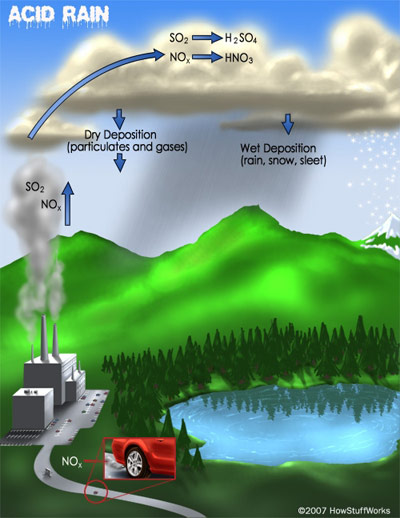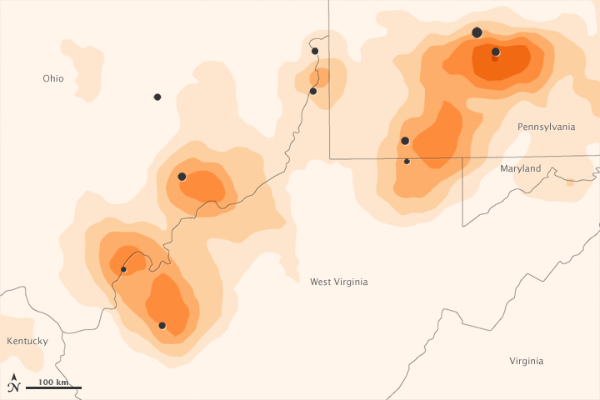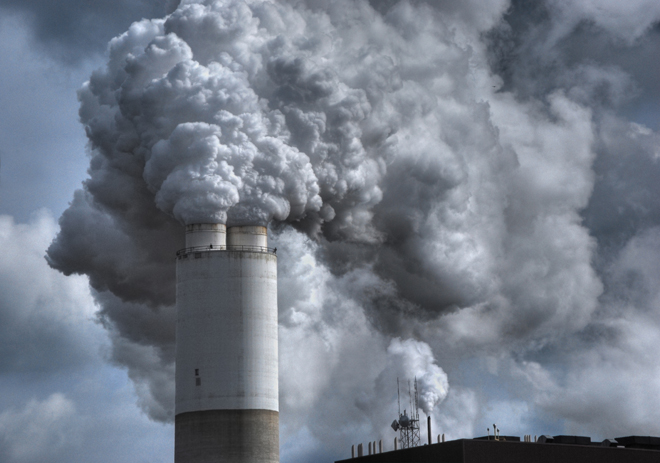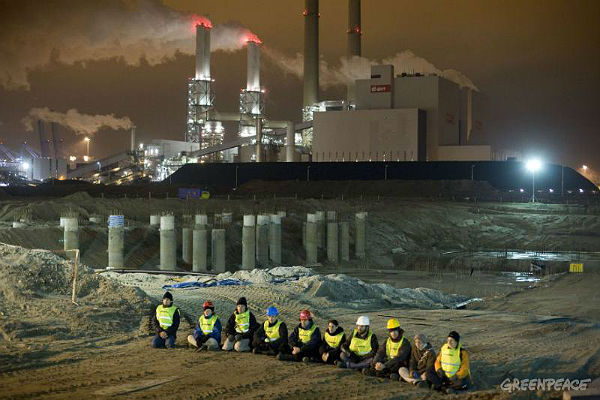NASA Satellite shows state of SO2 pollution from U.S. coal power plants

A key emission from coal-fired power plants that emitt sulfur dioxide contributes to the formation of acid rain and to respiratory health problems. Scientists attribute the decline to the Clean Air Interstate Rule, issued by the U.S. Environmental Protection Agency in 2005. The regulation capped SO2 pollution emissions but left it up to power companies to determine how to reduce them. In response, many power plants installed desulfurization devices and took other steps to limit the release of sulfur dioxide. Geophysical Research Letters published details of the new research this month.
Scientists using the Ozone Monitoring Instrument (OMI) on NASA’s Aura satellite observed major reductions in sulfur dioxide (SO2) between 2005 and 2010 in Alabama, Georgia, Indiana, Kentucky, North Carolina, Ohio, Pennsylvania, and West Virginia. Led by Vitali Fioletov of Environment Canada, the research team found that sulfur dioxide levels near the region’s coal-fired power plants fell by nearly half since 2005.
Those reductions are visible in the maps above, which depict average SO2 concentrations along the Appalachian Mountain states from 2005 to 2007 (top) and 2008 to 2010 (bottom). Black dots on the map indicate the location and relative size of power plants.

The new observations from the Ozone Monitoring Instrument confirm ground-based measurements that had shown declining sulfur dioxide levels. While scientists have previously used OMI to observe SO2 within large plumes of volcanic ash or over heavily polluted cities, this is the first time the instrument has been used to observe such subtle details. Scientists developed a mathematical technique that makes it possible to detect emissions down to levels about four times lower than previously possible.
The research also demonstrates how scientists could monitor emissions throughout the world, even in places where ground measurements are sparse. The researchers focused their analysis on the United States to take advantage of a robust network of ground-based instruments which monitor emissions from smokestacks. The ground instruments logged a 46 percent decline in SO2 levels since 2005—a finding consistent with the 40 percent reduction observed by OMI. (EarthObservatory/NASA)

A third of all carbon dioxide emissions come from burning coal. It’s used to produce nearly 40 percent of the world’s power, and hundreds of new coal plants are planned over the next years if the industry gets its way. Apart from climate change, coal also causes irreparable damage to the environment, people’s health and communities around the world. While the coal industry itself isn’t paying for the damage it causes, the world at large is.
Governments across the world are allowing industry to spend hundreds of billion of dollars to build hundreds of new coal-fired power stations worldwide in the coming years. If they are built, CO2 emissions from coal are expected to rise 60 percent by 2030. This will undermine any international agreements to tackle climate change. These governments have in part been seduced by an illusion of “clean coal.” The result of a major public relations offensive by the coal industry including a number of dubious “technological fixes” that they claim make burning coal safe for the climate.
One of these Carbon, Capture and Storage (CCS) is a plan to capture carbon emissions from power stations and bury them underground. The technology won’t be ready for at least another 20 years, too late to save the climate. Yet the vague promises of CCS are being used to justify building new coal-fired plants. These plants will spew out enormous amounts of CO2 pollution for at least the next 20 years and probably during their whole 40-year lifetime. In short, any new coal fired power plant will contribute massively to the climate crisis. (GreenPeace)

Carbon dioxide (CO2)
On average one 500-megawatt coal-fired power plant produces approximately 3 million tons/year of CO2. Each plant’s emissions depend on its size and efficiency. A single power station in Martins Lake, Texas emitted more than 21 million tonnes of CO2 in 2006 – more CO2 than Slovenia, Estonia, Bolivia or Afghanistan emitted in 2004.
Worldwide, the 25 worst CO2 polluting power plants all burn coal. According to CARMA, these plants are responsible for over 570 million metric tonnes of CO2 emissions, the equivalent to the UK’s yearly fossil fuel related CO2 emissions.
Acid rains
Coal-burning power plants are a significant source of Sulphur dioxide (SO2) and nitrogen oxides (NOx), which are major players in acid rain and ground level ozone (smog). Nitrogen oxides are also greenhouse gasses that react with organic compounds to form smog, which damages plant life, making it vulnerable to disease and extreme weather. It can also impair human health by causing increased risk of asthma, lung damage and premature death.

Acid rain occurs when SO2 and NOX interact with water, oxygen, and other chemicals in the air to form sulphuric acid and nitric acid. This toxin can fall from the sky in rain over a widespread area, killing fish and plants. Forests are also impacted via direct damage to foliage and where forest soils have been stripped of nutrients by acid rain. The shocking impacts of acid rain on forests around the world have led to progress, in curbing toxic rain in the US and Europe for example, but it is estimated that acid rain still falls on 30 percent of the land in China, and on hundreds of its cities.
The fact remains that coal is still by far the single biggest source of sulphur emissions caused by power generation. In 2004, 95 percent of the 10.3 million tons of SO2, and 90 percent of the 3.9 million tons of NOx, released into the atmosphere by US power plants came from ones fuelled by coal.


Commenting rules and guidelines
We value the thoughts and opinions of our readers and welcome healthy discussions on our website. In order to maintain a respectful and positive community, we ask that all commenters follow these rules.